
Oliver Cromwell was an English statesman, politician, and soldier, widely regarded as one of the most important figures in British history. He came to prominence during the Wars of the Three Kingdoms, initially as a senior commander in the Parliamentarian army and latterly as a politician. A leading advocate of the execution of Charles I in January 1649, which led to the establishment of the Commonwealth of England, he ruled as Lord Protector from December 1653 until his death in September 1658.

Hans Holbein the Younger was a German-Swiss painter and printmaker who worked in a Northern Renaissance style, and is considered one of the greatest portraitists of the 16th century. He also produced religious art, satire, and Reformation propaganda, and he made a significant contribution to the history of book design. He is called "the Younger" to distinguish him from his father Hans Holbein the Elder, an accomplished painter of the Late Gothic school.
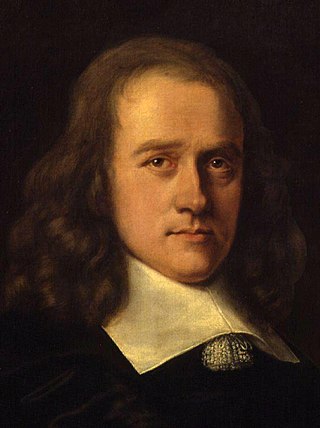
John Thurloe was an English politician who served as secretary to the council of state in Protectorate England and spymaster for Oliver Cromwell and held the position of Postmaster General between 1655 and 1660. He was from Great Milton in Oxfordshire and of Lincoln's Inn.

Ernest Crofts was a British painter of historical and military scenes.

Cornelius Johnson was an English painter of portraits of Dutch or Flemish parentage. He was active in England, from at least 1618 to 1643, when he moved to Middelburg in the Netherlands to escape the English Civil War. Between 1646 and 1652 he lived in Amsterdam, before settling in Utrecht, where he died.
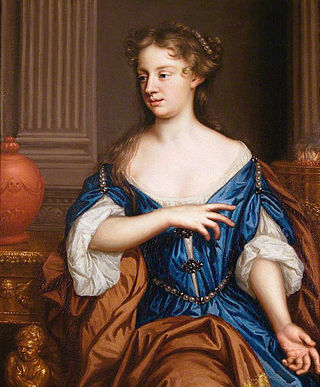
Mary Beale (née Cradock) (1633–1699) was an English portrait painter. She was part of a small band of female professional artists working in London. Beale became the main financial provider for her family through her professional work – a career she maintained from 1670/71 to the 1690s. Beale was also a writer, whose prose Discourse on Friendship of 1666 presents a scholarly, uniquely female take on the subject. Her 1663 manuscript Observations, on the materials and techniques employed "in her painting of Apricots", though not printed, is the earliest known instructional text in English written by a female painter. Praised first as a "virtuous" practitioner in "Oyl Colours" by Sir William Sanderson in his 1658 book Graphice: Or The use of the Pen and Pensil; In the Excellent Art of PAINTING, Beale's work was later commended by court painter Sir Peter Lely and, soon after her death, by the author of "An Essay towards an English-School", his account of the most noteworthy artists of her generation.

Robert Walker (1599–1658) was an English portrait painter, notable for his portraits of the "Lord Protector" Oliver Cromwell and other distinguished parliamentarians of the period. He was influenced by Van Dyck, and many of his paintings can now be found at the National Portrait Gallery, London.
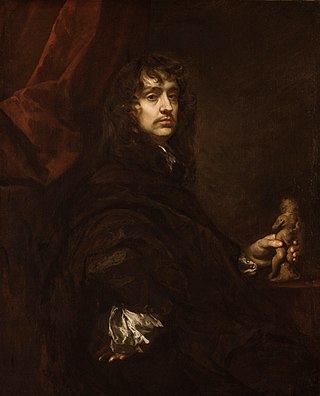
Sir Peter Lely was a painter of Dutch origin whose career was nearly all spent in England, where he became the dominant portrait painter to the court. He became a naturalised British subject and was knighted in 1679.

The Weeping Woman is a series of oil on canvas paintings by Pablo Picasso, the last of which was created in late 1937. The paintings depict Dora Maar, Picasso's mistress and muse. The Weeping Woman paintings were produced by Picasso in response to the bombing of Guernica in the Spanish Civil War and are closely associated with the iconography in his painting Guernica.

Cromwell on his Farm (1874) is a painting by the English artist Ford Madox Brown which depicts Oliver Cromwell observing a bonfire on his farm and thinking of a passage in the Book of Psalms: "Lord, how long wilt thou hide thyself – forever? And shall thy wrath burn like fire?". The words are inscribed on the painting's frame along with a quotation from one of Cromwell's speeches, in which he describes his life before entering into politics: "living neither in any considerable height, nor yet in obscurity, I did endeavour to discharge the duty of an honest man."
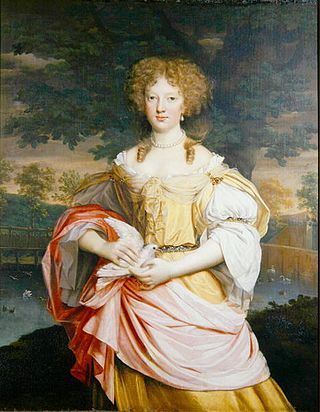
John Michael Wright was an English painter, mainly of portraits in the Baroque style. Born and raised in London, Wright trained in Edinburgh under the Scots painter George Jamesone, and sometimes described himself as Scottish in documents. He acquired a considerable reputation as an artist and scholar during a long sojourn in Rome. There he was admitted to the Accademia di San Luca and was associated with some of the leading artists of his generation. He was engaged by Archduke Leopold Wilhelm of Austria, the governor of the Spanish Netherlands, to acquire artworks in Oliver Cromwell's England in 1655.

The portraiture of Queen Elizabeth I (1533–1603) spans the evolution of English royal portraits in the early modern period (1400/1500-1800), from the earliest representations of simple likenesses to the later complex imagery used to convey the power and aspirations of the state, as well as of the monarch at its head.

The Death of Actaeon is a late work by the Italian Renaissance painter Titian, painted in oil on canvas from about 1559 to his death in 1576 and now in the National Gallery in London. It is very probably one of the two paintings the artist stated he had started and hopes to finish in a letter to their commissioner Philip II of Spain during June 1559. However, most of Titian's work on this painting possibly dates to the late 1560s, but with touches from the 1570s. Titian seems never to have resolved it to his satisfaction, and the painting apparently remained in his studio until his death in 1576. There has been considerable debate as to whether it is finished or not, as with other very late Titians, such as the Flaying of Marsyas, which unlike this has a signature, perhaps an indication of completion.

Catherine Howard was Queen of England from July 1540 until November 1541 as the fifth wife of King Henry VIII. She was the daughter of Lord Edmund Howard and Joyce Culpeper, a cousin to Anne Boleyn, and the niece of Thomas Howard, 3rd Duke of Norfolk. Thomas Howard was a prominent politician at Henry's court. He secured her a place in the household of Henry's fourth wife, Anne of Cleves, where Howard caught the King's interest. She married him on 28 July 1540 at Oatlands Palace in Surrey, just 19 days after the annulment of his marriage to Anne. He was 49, and it is widely accepted that she was about 17 at the time of her marriage to Henry VIII.

Madame Moitessier is a portrait of Marie-Clotilde-Inès Moitessier begun in 1844 and completed in 1856 by Jean-Auguste-Dominique Ingres. The portrait, which depicts Madame Moitessier seated, is now in the collection of the National Gallery in London, which acquired it in 1936.

Isaac Sailmaker was an etcher and marine painter of the Baroque period, who had a long career in England. He was referred to in contemporary books and journals as "the father of British sea painting", but was eclipsed by his contemporaries, the Dutch marine painters Willem van de Velde the Elder and his son Willem van de Velde the Younger, who for a period dominated the London market. Sailmaker was commissioned by the English Lord Protector, Oliver Cromwell, to paint the English fleet at Fort-Mardyck.

Richard Gibson, known as "Dwarf Gibson", was a British painter of portrait miniatures and a court dwarf in England during the reigns of Charles I, Oliver Cromwell, Charles II, and William III and Mary II.

Sir Thomas More and His Family is a lost painting by Hans Holbein the Younger, created circa 1527 during Holbein’s first visit to England. The work depicted the noted statesman and scholar Sir Thomas More, his immediate family, and other members of his household. While the original painting was destroyed in a fire in 1752, at Schloss Kremsier, the Moravian residence of Carl von Liechtenstein, Archbishop of Olmutz, its composition is known through a number of surviving copies and studies. The painting is known for demonstrating the interplay of Sir Thomas More's private and public life.
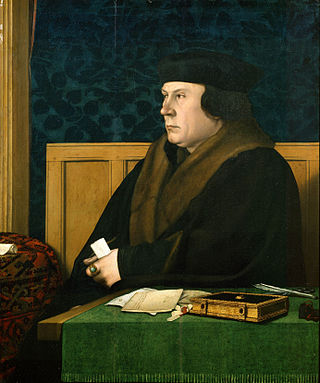
Portrait of Thomas Cromwell is a small oil painting by the German and Swiss artist Hans Holbein the Younger, usually dated to between 1532 and 1534, when Cromwell, an English lawyer and statesman who served as chief minister to King Henry VIII of England from 1532 to 1540, was around 48 years old. It is one of two portraits Holbein painted of him; the other is a tondo from a series of medallions of Tudor courtiers.



















